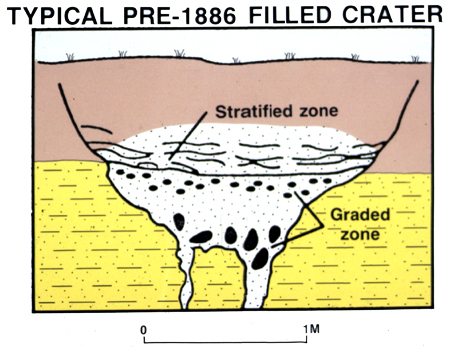

52. Schematic depiction of the photograph in the previous slide, showing the two distinct zones of bedding that were found in all filled circular craterlets. The lower portion is a graded zone in which the black pieces (clasts of humate-cemented sand) have sizes that are smaller upward. This graded zone is representative of how the heavier, large clasts sank to the bottom in a boiling caldron of liquefied sand and water immediately after the crater was formed. The horizontally stratified zone represents the filling in of the craterlet after the earthquake in the following years. The filling took place by sloughing of the sidewalls into the craterlet. (The infilling was probably very fast in the initial phases, as indicated by the sharpness of the contact between the graded and the horizontally stratified zones.) Last, a humate-enriched zone formed in the upper portion of the filled craterlet. A feeder dike typical of those for the craterlets, more or less circular in plan view, extends down from the base of the bowl-shaped portion of the crater and into the source sand at depth. (The circular feeder dike probably is the typical morphology in worldwide field settings where craterlets develop at the surface, especially where the cap is sand-rich and friable.)
For more information, contact Stephen F. Obermeier